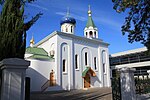Unley, South Australia
Adelaide geography stubsPopulated places established in 1840Suburbs of AdelaideUse Australian English from August 2019

Unley is an inner-southern suburb of Adelaide, South Australia, within the City of Unley. The suburb is the home of the Sturt Football Club in the South Australian National Football League (SANFL). Unley neighbours Adelaide Park Lands, Fullarton, Hyde Park, Malvern, Parkside and Wayville. The boundaries of Unley are Greenhill Road (north), Unley Road, Maud Street and Windsor Street (east), Cremorne Street and Opey Avenue (south) and King William Road (west). Unley is the family name of the wife of Thomas Whistler, owner of land in Unley which was laid out around 1857.
Excerpt from the Wikipedia article Unley, South Australia (License: CC BY-SA 3.0, Authors, Images).Unley, South Australia
King William Road, Adelaide Unley
Geographical coordinates (GPS) Address Nearby Places Show on map
Geographical coordinates (GPS)
| Latitude | Longitude |
|---|---|
| N -34.95 ° | E 138.6 ° |
Address
Stop 4 King William Road - East side
King William Road
5061 Adelaide, Unley
South Australia, Australia
Open on Google Maps




